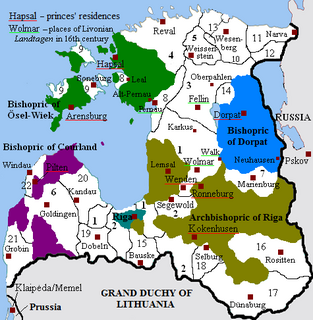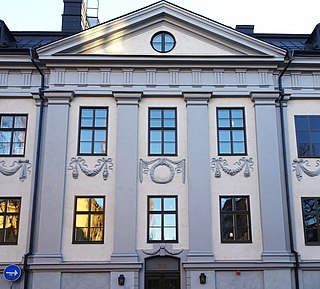
The Baltic Sea is an arm of the Atlantic Ocean, enclosed by Denmark, Estonia, Finland, Germany, Latvia, Lithuania, Poland, Russia, Sweden and the North and Central European Plain.

Livonia is a historical region on the eastern shores of the Baltic Sea. It is named after the Livonians, who lived on the shores of present-day Latvia.
The Northern Crusades or Baltic Crusades were Christian colonization and Christianization campaigns undertaken by Catholic Christian military orders and kingdoms, primarily against the pagan Baltic, Finnic and West Slavic peoples around the southern and eastern shores of the Baltic Sea, and to a lesser extent also against Orthodox Christian Slavs.

The Council of the Baltic Sea States (CBSS) is a regional intergovernmental organisation working on three priority areas: Regional Identity, Safe & Secure Region and Sustainable & Prosperous Region. These three priority areas aim to address the themes of sustainable development, environment, sustainable maritime economy, education, labour, culture, youth engagement, civil security, children's rights and trafficking in human beings.

The northern region of Europe has several definitions. Narrower definitions may describe Northern Europe as being roughly north of the southern coast of the Baltic Sea, which is about 54°N, or may be based on other geographical factors such as climate and ecology.

The Baltic states or the Baltic countries is a modern unofficial geopolitical term, typically used to group three countries: Estonia, Latvia, and Lithuania. All three countries are members of NATO, the European Union, the Eurozone, and the OECD. The three sovereign states on the eastern coast of the Baltic Sea are sometimes referred to as the "Baltic nations", less often and in historical circumstances also as the "Baltic republics", the "Baltic lands", or simply the Baltics.

The Dominions of Sweden or Svenska besittningar were territories that historically came under control of the Swedish Crown, but never became fully integrated with Sweden. This generally meant that they were ruled by Governors-General under the Swedish monarch, but within certain limits retained their own established political systems, essentially their diets. Finland was not a dominion, but an integrated part of Sweden. The dominions had no representation in the Swedish Riksdag as stipulated by the 1634 Instrument of Government paragraph 46: "No one, who is not living inside the separate and old borders of Sweden and Finland, have anything to say at Riksdags and other meetings..."

The terms Baltic Sea Region, Baltic Rim countries, and the Baltic Sea countries/states refer to slightly different combinations of countries in the general area surrounding the Baltic Sea, mainly in Northern and Eastern Europe.

Europe, the westernmost portion of Eurasia—is often divided into regions and subregions based on geographical, cultural or historical criteria. Many European structures currently exist. Some are cultural, economic, or political; examples include the Council of Europe, the European Broadcasting Union with the Eurovision Song Contest, and the European Olympic Committees with the European Games. Russia dominates the continent by both area and population; spanning roughly 40% of its total landmass, with over 15% of its total population.
Miss Scandinavia is a beauty pageant for Nordic females. The contest was merged with the Miss Baltic Sea pageant for the years 2007 and 2008 and after that the merged pageant was also discontinued.

The Baltic Marine Environment Protection Commission is an intergovernmental organization governing the Convention on the Protection of the Marine Environment of the Baltic Sea Area. A regional sea convention and a platform for environmental policy making at the regional level, HELCOM works for the protection of the marine environment of the Baltic Sea. HELCOM consists of ten members – the nine Baltic Sea countries Denmark, Estonia, Finland, Germany, Latvia, Lithuania, Poland, Russia and Sweden, plus the European Union.

BALTOPS is an annual military exercise, held and sponsored by the Commander, United States Naval Forces Europe, since 1971, in the Baltic Sea and the regions surrounding it.
The timeline of the occupation of the Baltic states lists key events in the military occupation of the three countries – Estonia, Latvia and Lithuania – by the Soviet Union and by Nazi Germany during World War II.
Miss Europe 2002, was the 55th edition of the Miss Europe pageant and the 44th & final edition under the Mondial Events Organization. After this edition Mr. Roger Zeigler sold the pageant to Endemol France. This years pageant was held at the Beirut International Exhibition & Leisure Center in Beirut, Lebanon on 28 December 2002. Svetlana Koroleva, Miss Russia, was crowned Miss Europe 2002 by outgoing titleholder Elodie Gossuin of France.
Miss Europe 1994 was the 49th edition of the Miss Europe pageant and the 38th edition under the Mondial Events Organization. It was held in Istanbul, Turkey on September 30, 1994. Lilach Ben-Simon of Israel, was crowned Miss Europe 1994 by out going titleholder Arzum Onan of Turkey.
The Baltic Sea Games was a multi-sport event between countries near the Baltic Sea. It was held on two occasions: first in 1993 then for a final time in 1997.









